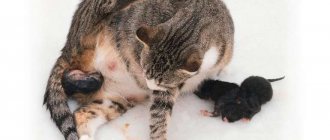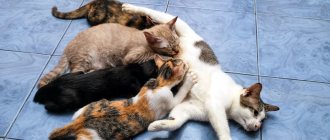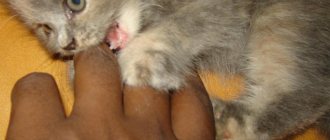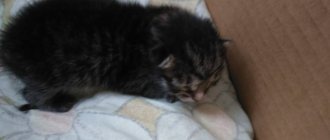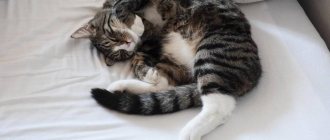Pregnancy of a pet is a joyful and important event. Cats become sexually mature by 6-8 months and, if the owner does not plan to sterilize her, you need to be prepared for childbirth. When a female gives birth for the first time, it is especially exciting.
Nature made sure that cats did everything on their own, but sometimes it needs to be stimulated. Street animals often find a secluded place and do not bother their owners. But helping a cat give birth in a city apartment is often necessary.
How to prepare? What to do when your cat doesn't push well? What drugs should I use? When to see a doctor? What to do if a cat gives birth for the first time? We will answer these and other questions further.
Stages of pregnancy
Short-haired and hairless breeds bear kittens for 55-65 days, long-haired breeds - up to 75 days. Pregnancy time also depends on the number of babies in the womb. The more kittens, the faster the birth will occur. However, if there are 1-2 cubs in the litter, then they can be expected with some delay.
ATTENTION! Sometimes one meeting with a male is not enough. Conception can occur a third or subsequent times, so it is difficult to determine the exact date of pregnancy at home.
Let's trace the stages of pregnancy for clarity:
- By the 20th day, the cat’s nipples become rounded, turn pink, and may peel. The female moves less and avoids high surfaces. He prefers sleep to active games and eats heavily several times a day. The belly increases slightly, but in long-haired breeds this is not noticeable. When palpating, you can feel the developing fetus, but this should be done carefully, because hasty actions will harm both the cat and the baby.
- From day 40, the fetus begins to actively develop. Gradually, limbs, head, and tail are formed. Internal organs are being formed and the nervous system is developing. Subsequently, the fetus acquires features inherent in cats, and also acquires sparse hair. The cat gradually loses its appetite.
- By week 6, the fruits descend into the abdominal cavity and stretch out. The belly is noticeably rounded, but if there are only one or two kittens, the changes are practically invisible. The abdominal cavity increases noticeably and takes the shape of a pear.
- After the 50th day, future kittens move actively. If there are many of them, then there is not enough space for everyone. The cat is experiencing discomfort. The expectant mother experiences vaginal discharge and colostrum appears from the nipples. The pelvis relaxes, and any day now the cat will give birth. She restlessly walks around the apartment or lies for a long time in a pre-prepared nest.
Maine Coon, British, Persian and Sphynx cats often require owner intervention and, in rare cases, veterinary intervention.
Video text
INSTAGRAM (watch more videos): afina_cattery
Would you like to say “THANK YOU” to the Afina-TV channel? Material gratitude and support are welcome! Link for quick donations (from anywhere in the world in any currency, any amount): https://www.donationalerts.ru/r/afinatv
Collecting on camera: My dollar WebMoney: WMZ Z351834018916
My hryvnia WebMoney: WMU U256338536053 THANK YOU FOR YOUR SUPPORT.
Website where our kittens are sold: www.afina-tv.com
ADVERTISING on the Afina-TV channel: www.afina-tv.com/vashareklama/My email VK group: https://vk.com/afina_tv_cat FB group: https://www.facebook.com/catteryafina/
INFORMATION FOR CHILDREN: Channel of my daughter Katya, who is 6 years old: https://www.youtube.com/channel/UCFMN.
The cat Fifa CANNOT give birth by herself: 2 ACTIONS, after completing which your cat will give birth WITHOUT CESAREAN
Preparation
Preliminary measures will not be superfluous, although most breeds cope well with pregnancy on their own. So what should you do if your cat gives birth for the first time?
First, we set up a nest. A regular cardboard box is perfect for this. We put a diaper or any other fabric on the bottom for convenience. Experienced owners recommend using several layers of soft paper or baby diapers. Special houses for cats are suitable for nesting. The main thing is that the expectant mother has free access.
Secondly, the cat should build a nest in a warm, ventilated room. We exclude drafts and the presence of other animals. We exclude the toilet and bathroom. The ideal option would be a small room where the cat will not be disturbed. For example, a storage room.
Thirdly, in order for the pet to successfully give birth, it is provided with food and clean drinking water. All this is placed near the nest or place where the cat prefers to sleep. Presumably she will give birth there.
What items will be needed to help the cat, stimulate and speed up the process? The list may change, but if the owner has most of the above, then half the battle is already done:
- Disposable diapers and wet wipes.
- Scissors.
- Disposable syringes and a number of medications to eliminate complications.
- Vaseline oil to stimulate the vaginal muscles.
- Surgical (or silk) thread to tie the umbilical cord.
- Iodine, brilliant green, disinfectants.
Animal behavior
Pregnant cats also change their behavior. From the first weeks, you can notice that expectant mothers become inactive: they will not play with you, jump, jump with the same desire, they prefer to spend more time lying down, sleeping longer.
Sometimes a cat can show anxiety: look under furniture, sniff things, meow. Try to calm her down, and the worries will pass.
Also, pets become more affectionate and sociable. They will follow the person and look for support, laying down next to you.
Photo: pregnant cats are inactive
The cat can climb onto your bed, snuggle and fall asleep, so she will feel calmer. Don't send her away. Spend time with your mother cat more often, this will help calm her down.
Pregnant pets sometimes surprise their owners with sudden changes in mood and behavior. She may be sleepy in the morning, but start running in the evening. A usually sociable cat may become quiet for a while and try not to be seen.
Don't be offended by her if she hisses at you for no apparent reason - pregnant cats are prone to mood swings. After a while, she will definitely come up with a purring apology.
In the last weeks of pregnancy, cats become heavy and can no longer jump onto their favorite chair with the same ease. Try to help them. It will be better if by this time you have already made a “nest” that will stand on the floor.
Causes of problems
Taking a dip at home is quite easy. It doesn’t matter if it’s a village house or a city apartment. But in some cases, the pregnancy period has passed, and the cat still does not give birth, although all the signs are obvious. The kittens will continue to grow, taking away strength and energy. The larger the fetus, the more difficult the birth will be. They should not be tightened.
Let's list the main reasons why a cat is unable to go into labor on time:
- malposition;
- the kitten is too big;
- narrow pelvis;
- insufficient amount of lubricant;
- incomplete dilatation of the cervix;
- age of the cat;
- mechanical injury;
- inflammation of the genital organs;
- the cat is overweight;
- breed characteristics - dwarf, Himalayan;
- anatomical properties of the vaginal vault.
Weak labor activity stands out. There are two main types. The first is a slight tone of the uterus. It is caused by a lack of the hormone oxytocin. In rare cases, calcium. The second occurs when labor lasts more than a day, the cat has lost a lot of strength and can no longer push.
To avoid the problems described above, a pregnant cat is taken to a veterinarian before giving birth. He conducts examinations and makes recommendations if any of the listed anomalies are detected. In rare cases, hospital observation is required to prevent the death of a cat and its offspring. This could be a clinic in Moscow or a good provincial one.
What signs can you use to know that a cat is about to give birth?
A cat, just like a person, has certain signs that indicate impending birth:
- The animal is constantly kept in a box or on a bedding specially designed for childbirth.
- The cat moves around the house only to drink food or water, the rest of the time it lies and sleeps.
- If the owner gives hard and heavy food, she may refuse it completely, as an overfilled stomach leads to discomfort or pain.
- The external genitalia swell and become red.
Pregnant cat
- A small amount of red or yellow mucus may be released.
- Reddening of the nipples, the beginning of colostrum secretion, this indicates the established process of lactation.
- A few hours before the cat lambs, her mucous plug comes out, this indicates the beginning of the birth process.
- At the beginning of active contractions, the cat begins to meow loudly and protractedly.
- Often the animal tries to leave the family place, to hide from people, this should not be allowed so as not to harm the offspring.
Important! To avoid unpleasant consequences, you can first agree with a veterinarian to provide assistance during labor. There are clinics where a doctor can visit your home even at night
How to induce labor at home
It should be understood that there are a large number of drugs on the market. In any case, it is better to consult a veterinarian who will take into account the individual characteristics of the cat. A number of drugs are excellent at inducing and accelerating the birth of your pet.
Let's look at the main medications that are used for stimulation:
- Oxytocin. Perhaps the main drug used in difficult childbirth. However, incorrect dosage can lead to bleeding and cervical rupture. Before use, consultation with a veterinarian is required!
- Traumatin. Used as an analgesic and prophylactic for difficult childbirth. Travmatin is effective in healing wounds with damage to the genital organs. Prevents infection of the uterine cavity by pathogenic microbes.
- Gamavit. Directly stimulates the muscles of the uterus. Often used in prolonged labor and difficult cases.
- Calcium gluconate. A lack of this element often leads to complications along with oxytocin. The drug enhances labor activity as it acts. It also provokes the formation of milk. Used to relieve nervous tension after childbirth.
Lack of calcium leads to the development of eclampsia - acute postpartum depression, which negatively affects the nervous system and causes severe convulsions. In advanced cases it leads to the death of the animal.
Veterinary practice knows cases when labor can be induced without the use of medications. Let us note two main methods.
Option one
The owner puts on gloves. Puts the cat in a position where she goes to the toilet "in large quantities." Next, massage the abdomen in a circular motion. After a couple of minutes, dip your finger in Vaseline oil and insert it into the cat’s vagina about a centimeter. Circular movements are repeated again. Mechanical actions help stimulate and speed up labor.
Option two
When oxytocin is contraindicated for a cat for some reason or the owner does not risk using it, then the following method will come to the rescue. Using a disposable syringe, mix 2 ml of ascorbic acid, 4 ml of glucose, 4 ml of calcium gluconate. We administer intramuscularly or intravenously, but only after the female has given birth to her first baby.
For every 5 kg of weight, 1 ml of the resulting solution is sufficient. It is also used after childbirth as a prophylaxis against eclampsia.
Proper care of kittens
Mother cat really needs your attention and care. She should receive healthy food, essential vitamins and calcium. Usually the cat takes care of her babies herself, licks them, shows them where the papillae are. Instinct tells the cat how to behave so as not to crush the kittens.
But in very rare cases, if the cat is emotionally unstable and mentally ill, she may eat her kittens.
Cats do not like strange smells and become nervous when strangers disturb them. Protect your pet from possible stress, and then your pet will be able to fully enjoy her motherhood.
Stages of the procedure
Specialists note several stages that precede the birth of kittens. The cat walks restlessly, the babies are actively moving in the stomach.
The first stage of labor begins. It lasts up to 24 hours. The cat's body temperature drops by 2-3 degrees. This is a natural process. The cat actively licks the nipples or genitals. In some cases, vomiting is observed. It is better to transfer the expectant mother to a previously prepared nest. There she will feel safe and prepared for childbirth.
The cat's water breaks and her pulse quickens. Breathing is occasionally interrupted. The contractions began. The pet meows loudly, sometimes turning into a scream. The owner calms the cat down by talking and lightly stroking the belly.
The second stage begins. The abdominal and diaphragm muscles are activated. The cat is pushing hard and the baby is gradually moving forward. The amniotic sac partially ruptures and fluid flows from the vagina.
Many owners are interested: is a kitten born feet first or head first? In this, cats copy humans. Like a human baby, a kitten is born head first. But it is worth noting that birth with the pelvis or paws forward should not cause concern to the owner. This is natural for cats.
The mother licks the baby, freeing it from the amniotic sac. Cats often eat this afterbirth. It is rich in vitamins and minerals. But a large amount of afterbirth eaten causes indigestion. The optimal quantity for a female is 2 pieces. In most cases, the cat chews the umbilical cord on its own.
ATTENTION! The number of afterbirths exactly corresponds to the number of kittens. Sometimes their number does not match. This means that one of the placentas remained inside the uterus. It must be removed to prevent inflammation of the genital organs in the future.
The final, third stage comes into force. The animal's uterus comes to rest until the next kitten appears. The break between births lasts from 10 to 60 minutes. The cat can drink and rest a bit.
The time of birth is an individual value. But if they continue for more than 24 hours, you should contact your veterinarian.
At what age can a cat give birth?
Those owners who have not previously encountered cats should remember that sterilization should not be shelved, since these animals can begin to bear offspring very early. The average cat goes through puberty by the age of eight months. If a cat owner plans to have kittens, then it is better to bring the animal with a partner after a year. The best option would be the fourth heat.
A cat's pregnancy lasts about two and a half months.
It is very easy for a person who has a cat at home to understand when she begins to go into estrus, that is, into heat. Based on the behavior of the animal, it immediately becomes clear that the cat has matured.
The entire period of estrus in cats can be divided into three stages. The first lasts about three days. At this time, the animal will constantly rub against its legs and require a lot of attention. Then there will be several days of rolling on the floor meowing loudly. At this time, the cat often walks with its tail moved to the side. Then comes the third stage, when the discharge is still there, that is, the cat attracts males, but at the same time it becomes aggressive towards them. If fertilization does not occur, this period can last up to 20 days. In a fertilized cat, it is reduced to one week.
A cat's pregnancy lasts about two and a half months. At one time, an animal can give birth to an average of four to seven kittens, but a lot depends on the breed of the cat. A person should carefully monitor when a pet goes into labor. If they are premature, which is not uncommon for the first time, then the babies are unlikely to survive. It’s also bad when a cat can’t give birth for a long time.
For the expectant mother you need to prepare a bed
What kind of help will you need?
So, we figured out how to induce and stimulate labor. But in some cases complications may occur. You will need the owner's help. Let's look at the most common cases and specific actions. It is especially useful for people to know when a cat gives birth for the first time:
The fetus is large and does not pass through the uterus
We have found that it is preferable for a kitten to be born head first. There is nothing wrong with walking feet first, but it often causes complications for the cat. What to do if the fruit is large?
We put on gloves, having previously lubricated our fingers with Vaseline oil. We insert a finger into the vagina and feel the folds of the kitten’s paws. We move the baby from side to side, trying to stretch the limbs forward. We grab the paws in the area of the shoulder joint.
Sometimes the baby is far from the exit of the uterus. We provoke contractions in the cat by stretching the vagina.
The cat did not chew the umbilical cord
It is worth waiting 10-15 minutes; if the woman in labor does not take any action, then you need to help her. We squeeze the umbilical cord with two or three fingers at a distance of 3-4 centimeters from the kitten’s belly. We tie it with silk or surgical thread. We take sterile scissors in our hands. Surgical ones are better. We cut the umbilical cord. We treat the cut site with an antiseptic.
The kitten is not released from the amniotic sac
We wait one or two minutes and cut it ourselves. We take out the kitten and wrap it in cloth. We hold our head and bend our body so that our knees reach our chests. We perform the manipulations several times. Breathing should resume. If it does not appear, then perform artificial respiration. If necessary, remove amniotic fluid from the nose and ears with a pipette.
Kittens are still born
It’s a scary situation, but we don’t lose our composure. Sometimes severe contractions, low temperature or an abundance of mucus in the nasal cavity lead to the fact that the kitten only appears dead. We dry the baby. We clear the airways, turn the head down and gently shake. Next we put it on the mother’s chest.
The cat definitely gives birth to dead pets one after another. We palpate the female's belly. If one or two fetuses are felt, then immediately contact the veterinarian. A caesarean section may be required.
Can't give birth
If the female pushes weakly, then we use oxytocin, calcium gluconate or a solution of ascorbic acid and glucose. If the drugs do not help, then immediately contact the veterinarian. Resuscitation may be required.
The cat may bleed. If it continues for a long time, you should contact your veterinarian. The same applies to unpleasant vaginal discharge. There should be no sudden drop or rise in temperature.
If contractions last more than two hours, but labor has not begun, contact the clinic. This could be Moscow or any other city. It happens that two fruits try to pass at once.
Especially during the first birth, it is better not to take risks and seek help from specialists. Any complication will negatively affect the pet’s health. To the point of being unable to give birth again.
We use medications only after consultation with a veterinarian. It is good if another family member or friend provides assistance during childbirth.
What to do if the cat cannot give birth on her own
If a cat has insufficient contractions, they can be induced by stroking the animal's stomach and back with your hand.
If the kitten is stuck in the birth canal, it is necessary to pull it out. You need to pull it out carefully, you cannot pull the head, this can lead to fractures of the cervical vertebrae and the kitten will die. It is safer to pull on the folds of skin on the body or neck, or on the paws, alternately to the left and then to the right. In case of dry birth and leaked amniotic fluid, lubricate your fingers with Vaseline, and then begin to pull the kitten out. Try to pull the kitten along the cat's body, supporting the mother's abdomen with your other hand.
